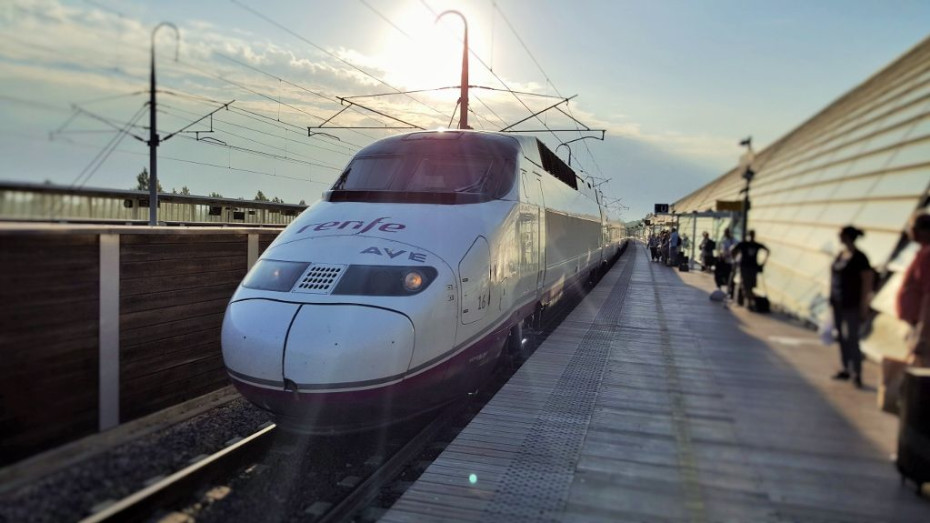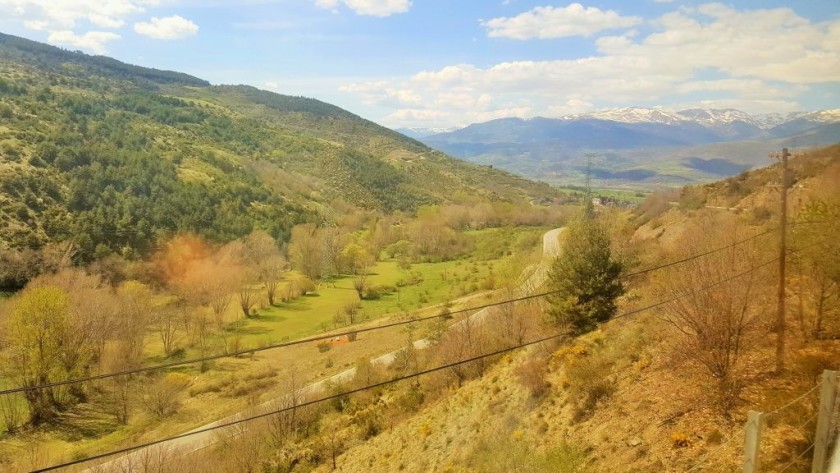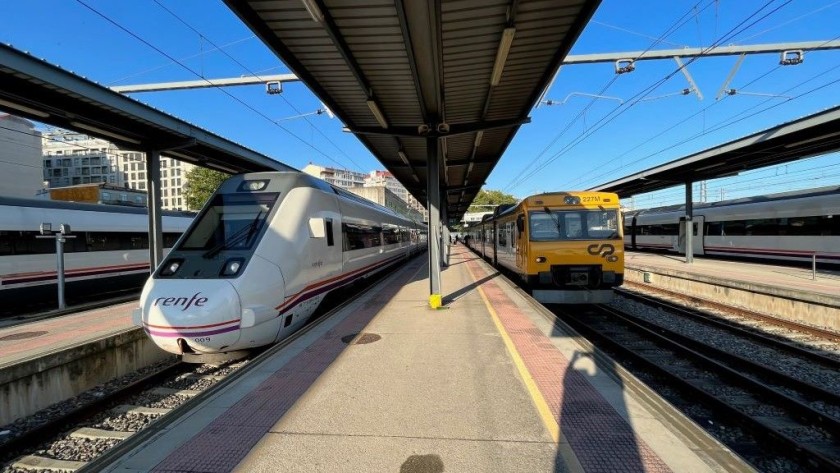Related Content
Content

International trains from Spain
Summaries of how to take trains from Spain to France and to/from Portugal
Share
Spain is served by comparatively few international rail services.
Only four routes taken by trains cross its long border with France and just 4 to 7 trains per day, depending on the time of year, use the high speed line that connects the two countries.
Despite this comparatively sparse high speed train service, it apparently justified the removal of all the overnight trains from Spain to France.
On both the Atlantic and Mediterranean coasts the local/regional trains are more frequent, but connections with trains on to other destinations in France need to be planned with care.
Trains from Spain to France
the high speed line from Figueres to Perpignan
French national rail operator, SNCF has been providing the direct TGV InOui service trains on the Paris ↔ Barcelona route, so there is two daily Paris ↔ Barcelona departures per day year round, plus and additional third summer service
Spanish national rail operator, Renfe, has revived the Lyon ↔ Barcelona and Marseille ↔ Madrid trains.
So these services are now available daily:
- Barcelona - Girona - Perpignan - Narbonne - Montpellier - Nimes - Lton
- Madrid - Zaragoza - Barcelona - Girona - Perpignan - Narbonne - Montpellier - Nimes - Avignon - Marseille
the route from Port Bou to Cerbere on the Mediterranean coast
The express trains from Spain to France on the Mediterranean coast take the high speed line, but French regional TER trains still travel on this older scenic route
They commence their journeys in Port Bou on the Spanish side of the border and travel to other cities in south-west France including Perpignan, Narbonne, Carcassonne, Beziers, Montpellier, Nimes and Avignon.
Other TER trains commence their journeys on the French side of the border in Cerbere.
There are regional Spanish trains from Barcelona to Port Bou, some of which travel over the border to terminate in Cerbere.
They are a mix of Regional-Express and MD services, but these are the only MD services in Spain on which seat reservations are not available.
The timetables on either side of the border isn't coordinated, as neither the French or Spanish trains operate to a regular timetable.
So the connections in either Cerbere can range from just 10 minutes between trains to more than 90 minutes.
The TER trains from Cerbere generally depart hourly - but don't serve the same destinations in each hour.
Some of the TER trains which commence their journeys from Port Bou only depart on Monday to Friday - and others are only available at weekends.
The departure times of the trains from Barcelona can also be different on a Sat/Sun than those on a weekday
Due to construction work, until further notice these trains will be departing from Sant Andreu station in Barcelona
This station is served by local Rodalies trains on lines R2 and R2 Nord, which call at [Barcelona Sants station](/train-travel-info/countries/spain/cities/barcelona/rail-stations/barcelona-sants/).
These trains to Port Bou also call at Passeig de Gràcia station, which is much closer to the heart of Barcelona than Sants station - those local connecting Rodalies trains also call at this station.
If tickets have sold out on the RENFE-SNCF high speed services from Spain to France, slower alternatives will be available
Particularly useful are the trains on to Avignon from Port Bou which typically depart at 14:04 (not Saturdays) and 16:04 daily.
Connecting trains usually depart Barcelona at 10:46 and 12:46 on Sat/Sun and at 11:16 and 13:16 on Monday to Friday.
Overnight from Barcelona to Paris:
A train to the French border town of Cerbere typically departs Barcelona Sants daily at 15:16 and it will arrive in Cerbere around 1hr 10 mins before the departure of an overnight Intercités de Nuit train to Paris at 19:07.
This train is available nightly until Sept 2nd,. but from then it typically departs on Fridays, Saturdays and Sundays, it is typically scheduled to arrive in Paris-Austerlitz station at 07:20.
the route from Irun to Hendaia / Hendaye on the Atlantic coast
Hourly local ‘Euskotren’ trains connect San Sebastian/Donastia to Hendaia/Hendaye via Irun.
Other hourly ‘Euskotren’ trains connect Bilbao to San Sebastian/Donastia.
So this can be a somewhat odd train journey across a border, as you'll be travelling on a train which has an aura of a metro service, but it is frequent and efficient.
In Hendaia/Hendaye the main railway station is steps away from the Euskotren terminus, so you can then connect into;
- TGVs to Paris which call in Biarritz and Bayonne and Bordeaux
- TER trains, on which rail pass users don't have to pay reservation fees, which take the same route as far as Bordeaux
- A daily direct TER train to Toulouse which typically departs daily at 10:19 and also calls in Pau, Lourdes and Tarbes; other connections to this route to Toulouse are available from Bayonne.
Though plan connections with care as none of these train services on from Hendaye/Hendaia depart frequently.
the route from Puigcerda to Latour De Carol:

This route threads a spectacular path through the Pyrenees mountain range.
Five trains per day depart Barcelona for Latour De Carol via Vic and Puigcerda; they are in effect commuter trains in Barcelona, that escape the city and head over the French border.
TER trains link La Tour De Carol to Toulouse on a route Foix, though the connections aren't generally conveniently timed.
Depart Barcelona at 06:01 or 08:31 daily, or at 11:31 on Monday to Friday, and you'll be hanging around La Tour De Carol for around 1hr 45mins - though you can cut this time down to only around 30 mins if you leave Barcelona at 11:31 on Sunday.
Your efforts will be rewarded as the middle section of the journey is fabulous.
From Madrid to Paris by train:
The options for travelling from Madrid to Paris by train are:
Option 2: connecting in Barcelona
Depart Madrid at 09:30; arrive Paris at 20:18
Take the daily regular AVE train, which will depart Madrid Atocha at 09:30 and arrive into Barcelona at 12:37, to make what should be a straightforward connection into the 13:25 train on to Paris, which is typically due to arrive into the French capital at 20:18.
Option 2: connecting in Irun and Hendaye
This option can be cheaper.
Depart Madrid at 08:43; arrive Paris at 20:55
- Taking the train, which typically departs from Madrid Chamartin at 08:43, beyond San Sebastian to its final station call at Irun, where it is usually due to arrive at 14:33.
- Making a transfer from the mainline station in Irun, to the station in the town used by the local Euskotren trains, which are similar to metro trains. The station is named Irun Colon and the walk will take around 7 to 12 mins; go straight ahead and on to the main road which will curve round and up to the right in order to bridge the railway, the station entrance will then be ahead on the left, it's sandwiched between some shops.
- Take the Euskotren train over the border to its terminus station at Hendaia, this station is steps away from the main Hendaye station. The Euskotren trains depart every 30 mins and the journey to Hendaia will only take 4 mins.
- A TGV train to Paris Montparnasse usually departs Hendaye daily at 16:12 and typically arrives in the French capital at 20:55.
Trains from Spain to Portugal
The train services between Spain and Portugal were drastically impacted by the pandemic
The overnight Trenhotel services to Lisbon from both Madrid and from Irun via Burgos were the only direct trains from Spain to the Portuguese capital and they have now been permanently withdrawn.
from Tul in northern Portugal to Valenca
There are two direct trains per day in each direction, which are branded 'Celta' and link Vigo in Spain with Porto in Portugal.
They also call at Nine (for connections to and from Braga) and Viano do Castelo and Valenca.
The journey experience is described in this fabulous article.
The Celta train service has different terms than the trains which solely operate within Portugal.
The key differences are;
- the discount is 40% for children
- the discount is 25%, for persons aged 60and older.
- one dog of up to 10kg can be carried per passenger, in an appropriate container which must not exceed 60x35x35cm.
The stations
In Porto these 'Celta' trains depart from and arrive at Porto-Camphana, the city's main station and in Vigo they depart from / arrive at Vigo-Guixar station.

The Regio trains that use the older 'classic' lines when travelling between Vigo and Pontevedra, Santiago de Compostela and La Coruna also depart from / arrive at Vigo-Guixar.
The image above was taken at the station by Jon Worth ad downloaded from Wikimedia Commons - Jon is a campaigner for better cross-border rail services in Europe, hence his excellent website.
However, this station is now the secondary station in Vigo, as the city now has a shiny new station dedicated to high-speed train services, named Vigo-Urzáiz.
Hence Vigo-Urzáiz station is used by faster trains to/from Pontevedra, Santiago de Compostela and A Coruna - And the trains which link Vigo with Madrid and Ourense.
to/from Barcelona via Leon and Zaragoza
The other train service which arrives at depart from Vigo-Guixar station is the 3 x days per week Alvia train on the Vigo ↔ Ourense - Leon - Burgos - Pamplona - Zaragoza - Barcelona route.
It departs from Vigo on Monday, Thursday and Saturdays; and arrives in the city on Wednesday, Friday and Sundays.
On the other days of the week connections are required in Ourense when travelling from and to Vigo.
Though this train departs Vigo before the first train of the day will arrive from Porto; and the train from Barcelona arrives in Vigo after the final train of the day has departed for Porto.
So an overnight stay in Vigo is required when travelling between Portugal and the destinations served by the Vigo ↔ Barcelona train.
On Google Maps it will look as though these two stations in Vigo are around 10 to 15 mins walk from each other, but the route is blocked by a highway and Vigo-Urzáiz is also at an upper level, on top of a hill in the city.
The local bus route / line 883039 links the two stations, but its service is so sporadic that taking a taxi is the only viable option for making a transfer between the two stations.
Though as will be seen below, an overnight stay in Vigo is often required when taking the longer rail journeys between Porto and the more distant locations in Spain.
Madrid to Porto
- Depart Madrid-Chamartin: 11:35 not Sundays
- Arrive Vigo Urzaiz: 15:32
- Taxi to Vigo Guixar
- Depart Vigo Guixar: 19:56
- Arrive Porto-Camphana: 21:18
The alternative to spending more than four hours in Vigo between trains:
- Depart Madrid-Chamartin: 14:40 not Saturdays
- Arrive Santiago De Compostela: 17:42
- Depart Santiago De Compostela: 18:32
- Arrive Vigo Urzaiz: 19:25
- Taxi to Vigo Guixar; note that this connection is not guaranteed
- Depart Vigo Guixar: 19:56
- Arrive Porto-Camphana: 21:18
A Coruña and Santiago De Compostela to Porto and Lisbon
- Depart La Coruna-San Cristobal: 05:30 on Monday to Friday
- Depart Santiago De Compostela: 06:11 on Monday to Friday
- Arrive Vigo Guixar: 07:40
- Depart Vigo Guixar: 08:58
- Arrive Porto-Camphana: 10:20
- Depart Porto-Camphana: 10:38 by IC train
- Arrive: Lisboa-Santa Apolónia: 14:00
A Coruña and Santiago De Compostela to Porto (pm)
- Depart La Coruna-San Cristobal: 15:50
- Depart Santiago De Compostela: 16:34
- Arrive Vigo Guixar: 18:03
- Depart Vigo Guixar: 19:56
- Arrive Porto-Camphana: 21:18
OR
- Depart La Coruna-San Cristobal: 17:00
- Depart Santiago De Compostela: 17:32
- Arrive Vigo Urzaiz: 18:26
- Taxi to Vigo Guixar
- Depart Vigo Guixar: 19:56
- Arrive Porto-Camphana: 21:18
the route through Badajoz to Lisbon and Porto
There aren't any direct daytime trains from Madrid to Lisboa/Lisbon or Porto, though on Monday to Saturday travelling this route has become easier on the new timetable.
Note that work is ongoing on the construction of a high-speed route between Madrid and Badajoz, as a consequence the timetables of the trains between these cities are subject to amendment and cancellation,
So these timings below are provisional and may not be available on your travel date.
They have been included to give an idea of what the journey by train typically entails.
Monday to Saturday to Lisbon
- Depart Madrid Chamartin at 08:30 by Alvia train
- Arrive Badajoz at 13:34
- Depart Badajoz at 14:09
- Arrive Entroncamento at 15:52
- Depart Entroncamento at 15:59 by IC train
- Arrive Lisboa Oriente station at 16:52
- Arrive Lisboa Santa Apolonia station at 17:00
Back up service departs Entroncamento an hour later.
Monday to Saturday to Porto
- Depart Madrid Chamartin at 08:30 by Alvia train
- Arrive Badajoz at 13:34
- Depart Badajoz at 14:09
- Arrive Entroncamento at 15:52
- Depart Entroncamento at 16:33 by IC train
- Arrive Porto-Camphana at 18:43
Daily to Lisbon
- Depart Madrid Chamartin at 10:55 by MD train (2nd class only)
- Arrive Merida at 15:22
- Depart Merida at 15:31 (option to depart at 18:20 not Saturday)
- Arrive Badajoz at 16:05
- Depart Badajoz at 19:41
- Arrive Entroncamento at 21:37
- Depart Entroncamento at 21:59 by IC train
- Arrive Lisboa Oriente station at 22:52
- Arrive Lisboa Santa Apolonia station at 23:00
from Portugal to Spain by train
Lisbon to Madrid: Daily
- Depart Lisboa-Santa Apolónia: 07:30 by IC train
- Arrive Entroncamento: 08:32
- Depart Entroncamento: 09:09 by Regional
- Arrive Badajoz: 12:54
- Depart Badajoz: 14:20 by R-train
- Arrive Merida: 15:06
- Depart Merida: 15:21 by MD train; 2nd class only - this connection is not guaranteed
- Arrive Madrid-Atocha Cercanias: 19:43
Lisbon to Madrid: not Saturday
- Depart Lisboa-Santa Apolónia: 12:30 by IC train
- Arrive Entroncamento: 13:32
- Depart Entroncamento: 13:36 by Regional train
- Arrive Badajoz: 17:26
- Depart Badajoz: 17:43 by Alvia train
- Arrive Madrid Chamartin at 22:18
Lisbon to Vigo
The train which departs at Porto at 08:13 leaves before the first train of the day will have arrived from Lisboa / Lisbon.
- Depart Lisboa-Santa Apolónia: 14:00 by AP train
- Arrive Porto-Camphana: 17:00
- Depart Porto-Camphana: 19:10
- Arrive Vigo Guixar: 22:34
The connections on the CP website suggest an 18 minute connection in Porto from an IC that departs Lisboa at 15:30, but this connection is not guaranteed.
Porto to Madrid
As will be seen below, travelling from Porto to Madrid by train in a single day is easier than making this rail journey in the opposite direction.
- Depart Porto-Camphana: 08:13
- Arrive Vigo Guixar: 11:35
- Depart Vigo Guixar: 12:31
- Arrive Pontevedra: 13:02
- Depart Pontevedra: 13:36
- Arrive Madrid-Chamartin: 17:36
This train to Madrid departs from Vigo Urzaiz station, but the connection in Pontevedra avoids the need to make the transfer between
stations in Vigo.
Porto to Santiago De Compostela and A Coruña
- Depart Porto-Camphana: 08:13
- Arrive Vigo Guixar: 11:35
- Depart Vigo Guixar: 12:31
- Arrive Santiago De Compostela: 14:06
- Arrive La Coruna-San Cristobal: 14:44
Please support ShowMeTheJourney
This second version of ShowMeTheJourney is exciting and new, so we are genuinely thrilled that you are here and reading this, but we also need your help.
We’re striving not to let anything get in the way of providing the most useful service possible, hence a facility has been set up with DonorBox which can be used to support the running costs and make improvements.
Instead of advertising or paywalls, your financial support will make a positive difference to delivering an enhanced service, as there’s a lot of ideas which we want to make happen.
So if you have found the info provided here to be useful, please go here to say thank you.
Look for a journey guide

Simon Harper
I wanted to share my passion for train travel and explain how anyone can take the fantastic journeys I have taken.

This is one of more than 100 train travel guides available on ShowMeTheJourney, which will make it easier to take the train journeys you want or need to make. As always, all images were captured on trips taken by ShowMeTheJourney.
This second version of ShowMeTheJourney is exciting and new, so we are genuinely thrilled that you are here and reading this, but we also need your help.
We’re striving not to let anything get in the way of providing the most useful service possible, hence a facility has been set up with DonorBox which can be used to support the running costs and make improvements.
Instead of advertising or paywalls, your financial support will make a positive difference to delivering an enhanced service, as there’s a lot of ideas which we want to make happen.
So if you have found the info provided here to be useful, please consider saying thank you.






